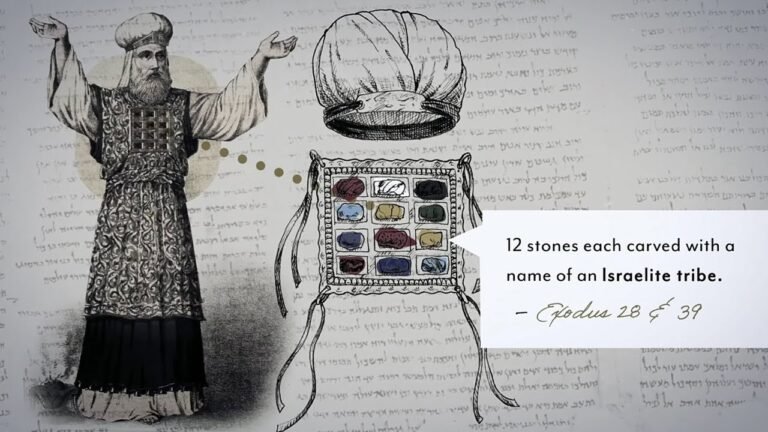Understanding Urim: Its Significance and Meaning
In the realm of ancient texts and religious traditions, the term Urim often sparks curiosity and intrigue. But what is Urim exactly? Rooted in biblical history, Urim refers to the sacred objects used by the high priests of Israel for divination and guidance. Typically associated with the enigmatic Thummim, these artifacts played a esencial role in decision-making processes, offering a divine connection in times of uncertainty. As we delve deeper into the significance and origins of Urim, we uncover not only its historical relevance but also its impact on spiritual practices throughout the ages.
- Urim refers to a set of divinatory objects mentioned in the Hebrew Bible, associated with the High Priest’s breastplate.
- The term is often paired with “Thummim,” and together they are believed to provide divine guidance or answers to questions posed by leaders.
- The exact nature and function of the Urim and Thummim remain unclear, with various interpretations suggesting they could involve casting lots or other methods of decision-making.
- Urim is thought to symbolize light or illumination, while Thummim is associated with truth or completeness.
- The use of Urim and Thummim was significant in ancient Israelite culture, particularly for kings and priests seeking God’s will in critical matters.
What is the meaning of Urim in the Bible?
In the biblical context, Urim is part of a sacred procedure used to seek divine guidance, often in conjunction with the term Tummim. Rooted in Hebrew, Urim translates to “lights,” suggesting a source of clarity and illumination in times of uncertainty. This practice was particularly significant for leaders and priests, as it allowed them to receive direction from God during pivotal moments in Israel’s history.
The Urim and Tummim were believed to be instruments for discerning God’s will, employed in decision-making processes that affected the community. References in scripture, such as Numbers 27:21 and 1 Samuel 28:6, underscore their importance as a channel for revelation. These terms embody the concept of seeking not just any guidance, but a perfect and illuminating insight into the divine plans.
Ultimately, the significance of Urim extends beyond mere functionality; it represents a profound relationship between the divine and the leaders of God’s people. In seeking “perfect light,” the faithful were reminded of their reliance on God for wisdom, underscoring the importance of spiritual discernment in navigating life’s challenges. Through this ancient practice, the quest for understanding and direction continues to resonate in theological discussions today.
What type of stone is Urim?
Urim is traditionally described as a remarkable stone characterized by its unique construction. It is made up of two smooth, three-cornered diamonds that are expertly set in glass. This intricate design is further enhanced by silver bows that connect the glasses, reminiscent of the elegant craftsmanship found in vintage spectacles.
The clarity of the stones is noteworthy, as most references highlight their transparent quality rather than any opacity. This transparency not only contributes to their aesthetic appeal but also symbolizes purity and illumination, making Urim a significant element in various cultural and historical contexts.
In essence, the design and clarity of Urim serve to elevate its symbolic importance, suggesting a connection to wisdom and divine communication. Its striking features and historical significance continue to fascinate scholars and enthusiasts alike, making it a compelling topic of discussion in the study of ancient artifacts.
How do Urim and Thummim appear?
In early descriptions, the Urim and Thummim were depicted as a pair of transparent stones, ingeniously set within silver bows, resembling a unique set of spectacles. This intriguing imagery conjures thoughts of ancient wisdom and divine guidance, emphasizing their importance in religious contexts. Their design not only served a practical purpose but also symbolized a connection to higher knowledge.
The term “Urim and Thummim” became linked to these interpreters in 1833, marking a significant moment in their historical narrative. Joseph Smith, the founder of the Latter-day Saint movement, adopted this biblical terminology to describe the artifacts he claimed to possess. This adoption reflects a blend of faith and tradition, illustrating how religious artifacts evolve in meaning over time.
Ultimately, the Urim and Thummim stand as powerful symbols of revelation and insight. Their distinctive appearance as spectacles signifies a means of seeing beyond the ordinary, allowing for spiritual clarity. As they continue to be referenced in various faiths, their legacy remains intertwined with the quest for understanding and divine truth.
Decoding the Mysteries of Urim
The Urim, often shrouded in historical enigma, serves as a fascinating artifact of ancient religious practice. Referred to in biblical texts as a tool for divine communication, these mysterious objects were believed to provide guidance to the high priests of Israel. Scholars speculate that the Urim, alongside the Thummim, functioned as a means of revealing God’s will, offering clarity during critical decision-making moments. Their exact nature and method of use remain subjects of debate, igniting curiosity among historians and theologians alike.
As we delve deeper into the significance of the Urim, we uncover a rich tapestry of symbolism and spirituality. The concept of seeking divine insight resonates across cultures and epochs, reflecting humanity’s enduring quest for connection with the divine. By examining the historical context and the theological implications of the Urim, we can better appreciate its role not just as a religious relic, but as a powerful metaphor for the search for truth and understanding in our own lives. This exploration invites us to consider how we seek guidance in our own journeys, echoing the age-old practice of looking beyond the surface for answers to life’s profound questions.
The Role of Urim in Ancient Traditions
In ancient traditions, the Urim played a pivotal role as a divine instrument for guidance and decision-making. Often associated with the High Priest of Israel, these sacred objects were believed to communicate God’s will to the leaders of the community. The Urim, along with the Thummim, provided a means for seeking answers on critical matters, from military strategies to personal dilemmas, embodying the intersection of faith and leadership in ancient society.
The significance of the Urim extended beyond mere consultation; it represented a tangible connection between the spiritual and the earthly realms. This duality allowed leaders to make informed choices while reinforcing their authority through divine endorsement. Communities looked to these practices with reverence, trusting that the outcomes derived from the Urim were guided by a higher power, thereby fostering a sense of unity and purpose among the people.
As time progressed, the use of the Urim faded, yet its legacy endured in various cultural narratives that emphasize the importance of seeking wisdom and divine insight. Ancient texts and traditions continue to reflect on the Urim’s role in shaping moral and ethical decisions, reminding us of the timeless quest for guidance in the face of uncertainty. The Urim serves as a symbol of the enduring human desire to connect with the divine and find clarity in a complex world.
Urim: A Symbol of Divine Guidance
Urim, often associated with the ancient practices of divination, serves as a profound symbol of divine guidance. Rooted in biblical tradition, the Urim was used by high priests to seek answers from God, representing a direct line of communication with the divine. This sacred tool transcends mere ritual; it embodies the quest for clarity and enlightenment amidst life’s uncertainties, reminding us of the importance of seeking higher wisdom.
In contemporary contexts, the concept of Urim can be interpreted as a metaphor for intuition and inner knowing. Individuals often find themselves at crossroads, yearning for direction in their personal and spiritual journeys. Just as the high priests relied on the Urim to discern God’s will, modern seekers can cultivate their inner voices to navigate complex decisions, fostering a deeper connection with their beliefs and values.
Ultimately, Urim stands as a testament to humanity’s enduring desire for guidance and understanding. Whether through prayer, meditation, or introspection, the pursuit of divine insight continues to resonate today. By embracing the essence of the Urim, we open ourselves to the possibility of transformation and growth, inviting clarity into our lives and nurturing a profound sense of purpose along our paths.
Unveiling the Spiritual Insights of Urim
The Urim, an ancient tool used by the high priests of Israel, serves as a profound symbol of divine communication. This enigmatic device, mentioned in the Hebrew Bible, is believed to have facilitated decision-making during critical moments in Israel’s history. By casting lots or revealing hidden truths, the Urim provided a tangible connection between the spiritual and earthly realms, illustrating the importance of seeking divine guidance in times of uncertainty.
Exploring the spiritual insights of the Urim reveals a deeper understanding of faith and reliance on a higher power. In a world often fraught with confusion and doubt, the Urim reminds us of the value of introspection and the quest for clarity. It encourages individuals to look beyond the material and to seek wisdom through prayer, meditation, or other spiritual practices, fostering a sense of inner peace and direction.
Ultimately, the legacy of the Urim extends beyond its historical context, inviting contemporary seekers to embrace its lessons. By acknowledging the role of divine insight in our lives, we can cultivate a more profound relationship with the spiritual aspects of our existence. This ancient practice challenges us to remain open to the signs and guidance that surround us, empowering us to navigate life’s complexities with confidence and purpose.
The Historical Context of Urim Explained
The Urim, a significant element of ancient Israelite culture, served as a divine oracle, guiding leaders through esencial decisions. Its origins are steeped in the early practices of the Israelite priesthood, where it was used alongside the Thummim, likely to discern God’s will in matters of state and religion. Historically, these artifacts played a pivotal role during tumultuous times, offering a sense of direction in a society often grappling with uncertainty and conflict.
As Israel transitioned from a loose confederation of tribes to a more centralized monarchy, the importance of the Urim grew. Kings like Saul and David sought its counsel during critical junctures, reinforcing the belief that divine guidance was essential for just leadership. This reliance on the Urim not only highlights the intertwining of faith and governance in ancient Israel but also reflects the broader human desire for clarity in the face of life’s challenges.
The exploration of Urim reveals its profound significance in ancient practices and beliefs, serving as a powerful symbol of divine guidance and decision-making. Understanding what Urim represents not only deepens our appreciation for historical contexts but also invites us to reflect on the ways we seek clarity and insight in our own lives today. As we navigate the complexities of the modern world, the lessons from Urim remind us of the enduring quest for truth and understanding that transcends time and culture.







